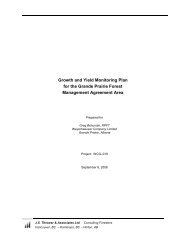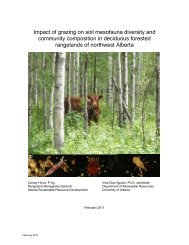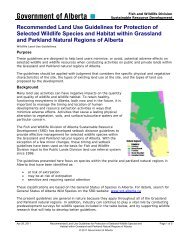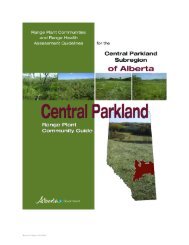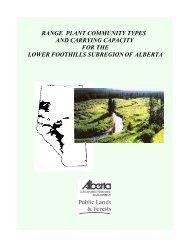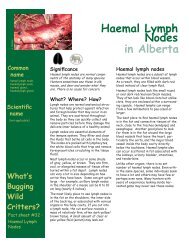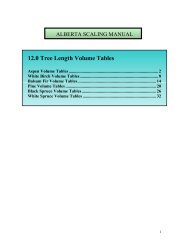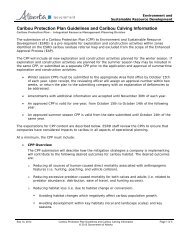Foothills Fescue Range Plant Community Guide - Sustainable ...
Foothills Fescue Range Plant Community Guide - Sustainable ...
Foothills Fescue Range Plant Community Guide - Sustainable ...
You also want an ePaper? Increase the reach of your titles
YUMPU automatically turns print PDFs into web optimized ePapers that Google loves.
Raspberry-Rose/Kentucky Bluegrass - Dandelion FFC1<br />
(Rubus idaeus - Rosa woodsii / Poa pratensis - Taraxacum officinale) Shrub Herbaceous<br />
n=10 This is a highly disturbed, early seral plant community associated with wetland and moist loamy<br />
range sites in the <strong>Foothills</strong> <strong>Fescue</strong> and foothills parkland Natural Subregions. Site determination is difficult<br />
given the subtle transition from upland to riparian conditions. It is more common in the foothills parkland<br />
Natural Subregion, but can be found in wetland and moist valley bottom locations in the <strong>Foothills</strong> <strong>Fescue</strong>.<br />
This community has been significantly modified by disturbance history leading to the replacement of tufted<br />
hair grass and sedges by a variety of non-native species including Kentucky bluegrass, Timothy, Canada<br />
thistle, dandelion and quack grass, thus diminishing the values and functions of the plant community.<br />
Heavy grazing can modify the plant community and reduce the depth and quality of the turfy surface layer.<br />
This in turn reduces the potential moisture holding capacity and water infiltration into the soil, and,<br />
increases overall runoff. The range site may appear to be more of a loamy upland site when the dominance<br />
of riparian species is diminished. The potential to restore this plant community to native condition appears<br />
very limited at this time, but productivity and vegetation cover can be significantly enhanced through<br />
rotational grazing. Though the potential for recovery of the herbaceous layers appears unlikely, there are<br />
many woody species that may release with more rest in the grazing cycle including: basket willow,<br />
Saskatoon, chokecherry, gooseberry and aspen. The Ecologically <strong>Sustainable</strong> Stocking Rate will allow<br />
range health to improve. Stocking at .7 to .9 AUM/ac will maintain the existing plant community.<br />
Soil Exposure: 1 % (0-10) Moss/Lichen Cover: 1% (0-4) Total Vegetation: 98% (98-98)<br />
PLANT COMPOSITION CANOPY COVER(%)<br />
MEAN RANGE CONST<br />
SHRUBS<br />
WILD RED RASPBERRY<br />
(Rubus idaeus) 7 0-40 90<br />
COMMON WILD ROSE<br />
(Rosa woodsii) 7 0-16 90<br />
SNOWBERRY<br />
(Symphoricarpos albus) 4 0-13 80<br />
FORBS<br />
COMMON DANDELION<br />
(Taraxacum officinale) 7 3-15 100<br />
WILD WHITE GERANIUM<br />
(Geranium richardsonii) 3 2-8 100<br />
GRASSES<br />
KENTUCKY BLUEGRASS<br />
(Poa pratensis) 15 1-48 100<br />
TIMOTHY<br />
(Phleum pratense) 6 0-9 100<br />
BLUEJOINT<br />
(Calamagrostis<br />
canadensis) 4 0-12 50<br />
UNDIFFERENTIATED SEDGE<br />
(Carex) 3 0-8 90<br />
FOWL BLUEGRASS<br />
(Poa palustris) 3 0-14 60<br />
TUFTED HAIR GRASS<br />
(Deschampsia cespitosa) 1 0-3 60<br />
ENVIRONMENTAL VARIABLES<br />
RANGE SITE:<br />
LOAMY 1, WETLAND, OVERFLOW<br />
SOILS:<br />
ORTHIC HUMIC GLEYSOL<br />
ORTHIC BLACK CHERNOZEM<br />
ELEVATION:<br />
SOIL DRAINAGE:<br />
POORLY DRAINED, IMPERFECTLY DRAINED<br />
MODERATELY WELL DRAINED<br />
WELL DRAINED<br />
SLOPE :<br />
VERY GENTLE, NEARLY LEVEL<br />
MODERATE<br />
ASPECT:<br />
NORTHERLY<br />
FORAGE PRODUCTION (LB/AC)<br />
GRASS NOT AVAILABLE<br />
FORB NOT AVAILABLE<br />
SHRUB NOT AVAILABLE<br />
LITTER NOT AVAILABLE<br />
TOTAL NOT AVAILABLE<br />
Ecologically <strong>Sustainable</strong> Stocking Rate<br />
0.5 AUM/ac<br />
57



